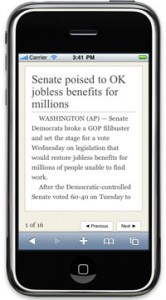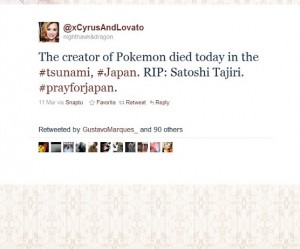 My April 2011 video clip of the month features a pre-release demonstration of the free open source dynamic publishing platform Treesaver. Online publications created with Treesaver automatically adjust to the size of any screen (you’ve got to see it in action).
My April 2011 video clip of the month features a pre-release demonstration of the free open source dynamic publishing platform Treesaver. Online publications created with Treesaver automatically adjust to the size of any screen (you’ve got to see it in action).
Treesaver is a lot like the Flipboard iPad app except it’s built with web standards—HTML, CSS, and Javascript. That means you can just design a publication once and the same code will work on any device with a web browser. You don’t have to waste money building an app for different types of smart phones, tablets, etc.
I first read about Treesaver on Beth’s Blog the same day I attended the National Emergency Management Association (NEMA) Social Media in Emergency Management (SMEM) Camp in Alexandria, Va. SMEM Camp featured a presentation on accessibility by Neil McDevitt, program director for the Community Emergency Preparedness Information Network (CEPIN). I had a eureka moment when I returned home and read on Beth’s Blog about why a Treesaver publication was so much better than a PDF:
What PDF’s do well is prepare a document for printing. But people are less and less likely to need printing. They are more likely to want to read that report on their computer, their iPad – some researchers suggest Apple could sell 25 million units in 2011 — or even their smart phone. The PDF is actually a terrible way to put content on the web. Why are PDFs so bad? Let me count the ways:
- They are slow to load
- They are in a fixed size, no matter on which screen you are looking at them
- They aren’t built for mobile devices
- You can’t link to a specific page inside the document – if you want to share one page on Facebook the best you can do is link to the whole document, and when your friend clicks and realizes it’s a 30 page PDF they hate you
To that excellent list I would add PDFs are not accessible, at least without a lot of extra work tagging and bookmarking (if you’ve ever made a PDF accessible for a federal government agency you know what I mean). For this and other reasons, PDFs are not recognised by the World Wide Web Consortium (W3C) as a standard web format.
So if you strive to serve all audiences, including the visually impaired, Treesaver’s, standards-based, user-friendly, and easy-to-read interface could definitely be for you. Treesaver publications with their adjustable screen widths are far more accessible than PDFs for people with poor eyesight (Treesaver publications, however, still require alt tags providing text equivalents for every non-text element to accommodate braille and voice readers).
Of course, accessiblity for the millions of smart phone and tablet users out there is important too. As any smart phone user can tell you, viewing a PDF on one of them is noooooo fun.
What do you think about PDFs? Are they on their way out or do you still love them? Please share your thoughts in the comments section.




